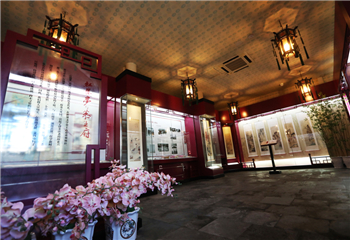
Dates: From March 2010 to now
Location: East side hall of Duofu Belvedere

The exhibit of Dream of the Red Chamber and the Prince Kung’s Palace Museum is held in the east side hall of Duofu Belvedere.
Dream of the Red Chamber is an excellent representation of traditional Chinese culture and holds an important position in the world of literature. The Rongguo Mansion, Ningguo Mansion and Daguanyuan (Grand View Garden) depicted by Cao Xueqin (1715-1763) in the novel have aroused much interest from readers.
Prince Kung’s Palace is the best preserved prince’s residence existing in China, which has a close relation with the Dream of the Red Chamber and has been an important venue for relevant research on the novel since 1978.
The exhibit focuses on the Cao family and Beijing’s princes’ residences, Dream of the Red Chamber and Prince Kung’s residence, and the prototype of the Daguanyuan. The large number of solid and fascinating documents and cultural relics on display reveal the unusual relation between history and literature.
Part one: The Cao family and princes’ residences in Beijing
Cao Xueqin’s ancestors were Han and became bondservants of Manchu aristocrats after being captured by the Latter Jin (1616-1636, a regime established by Nurhuaci and is a precursor to the Qing Dynasty) troops and were conscripted in the Eight Banners system in the late Ming Dynasty (1368-1644). After entering the Shanhai Pass following the Manchu troops, Cao’s ancestors were managed by the Imperial Household Department and became imperial servants for generations. Cao Xueqin’s great grandmother, with the surname Sun, was the nanny for the Kangxi Emperor (r. 1662-1722). Cao’s great grandfather Cao Xi was transferred from director of the Imperial Household Department to the superintendent of the Jiangning Imperial Silk Manufactory in today’s Nanjing. From then, three to four generations of the Cao family held the leading post of the agency for nearly 60 years, which led them to become an eminent aristocratic family. Cao’s grandfather, Cao Yin, was favored and trusted by the Kangxi Emperor, who stayed in the mansion of Cao’s Jiangning Imperial Silk Manufactory four times out of his six tours to southern China. According to historical records, the Cao family had close relations with the princes’ residences, which contributed to Cao Xueqin’s composition of the Dream of the Red Chamber.

The exhibit presents the Cao family’s close relations with the princes’ residences through documents.
Part two: Dream of the Red Chamber and the Prince Kung’s residence
Brilliant garden built in the west of the imperial palace
In the Dream of the Red Chamber, Cao Xueqin depicted a classic garden – Daguanyuan, which boasts the grandeur of the northern imperial garden and the elegance of the southern private garden. Since the publication of the book, disputes about the original location of the Daguanyuan have appeared in succession. Among them, the opinion prevailed in the late Qing Dynasty held that the Prince Kung’s Palace and the Shichahai area are the locations of the Jia’s Mansion and the Daguanyuan.

The exhibit illustrates the relationship between the Dream of the Red Chamber and the Prince Kung’s residence.
Prince Kung’s residence and research on the Dream of the Red Chamber
Prince Kung’s residence is an important place for more recent research on the Dream of the Red Chamber. The editorial group of the new proofread edition of the Dream of the Red Chamber, the Dream of the Red Chamber Research Institute of the Chinese National Academy of Arts, The Dream of the Red Chamber Journal, and the Chinese Dream of the Red Chamber Academy have all once installed in the Prince Kung’s residence. Many major events that had an impact on the development of Chinese redology took place here and many redology masters, cultural celebrities regularly visit the residence.

Dream of the Red Chamber books are on exhibit at the east side hall of Duofu Belvedere of the Prince Kung’s Palace Museum.
Part three: prototype of the Daguanyuan
Over the past 200 years or so, there have been more than a dozen opinions about Daguanyuan’s inspiration. The most representative ones include the Sui Garden in Nanjing, the Prince Chun’s Palace, the Prince Kung’s Palace in Beijing, the West Garden at the Jiangning Imperial Silk Manufactory in Nanjing and the imagined mansion created by the author.

The exhibit presents several options of the inspiration of Daguanyuan.